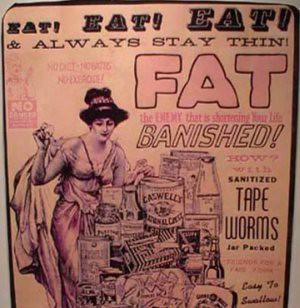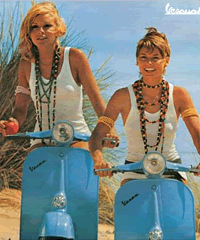Admin
Admin
Posts : 58
Join date : 2009-05-16
 |  Subject: A. What we learn... Subject: A. What we learn...  Thu Jul 30, 2009 4:46 pm Thu Jul 30, 2009 4:46 pm | |
| The history of female beauty and the image industry is a library in itself. Whatever the biological, psychological or sociological bent, women have always attracted men through their appearance. In times when a woman had very little else – education, political power or rights – she had her body. She could use this body to first attract a husband and then give him children, preferably sons. Or she could use her body to charm and seduce men in other less domestic ways, as courtesan, geisha or common streetwalker.1 Now Western women have many more choices. We are educated. We can vote and hold jobs and bank accounts. We are taught equality with men. Still, beauty remains a source of female power. “Every woman knows that, regardless of all her other achievements, she is a failure if she is not beautiful” writes British feminist Germaine Greer in a recent book.2 Men still hold most of the power. So, if a woman is beautiful, for a moment, she can have personal power over someone with economic and political power. Nowadays, she can be educated, talented and have money – good, but even better though is if she is educated, talented, wealthy and beautiful. Then she feels she can rule the world
In the last 130 years, trends in advertising to women happened quite deliberately and usually related to power dynamic between the genders. Prior to the French Revolution, both sexes of the upper class in the West focused on their appearance. With the Revolution, values turned toward democratic ideals. Men worked increasingly outside the home and found value and identity through their work, not their looks. Historian Lois Banner writes about the "Cinderella Mythology" which developed for 19th century women alongside the new ideal of the modern "self-made man." A man worked hard to earn money and garner properties. If his wife had time and resources to pursue beauty, this indicated the husband's level of sucess. Banner continues, "Fashion represented fun and self-indulgence - the way elite life was meant to be." In the U.S. culture of strong Protestant work ethic, this quest for "appearance success" took on even stronger moral implications. The strange and dangerous bedfellows of working hard to look good.3
Cities were growing. Talk of revolution, progress and rights flourished, as did general information about how things worked elsewhere. As humanity marched vigorously forward toward a new 20th century, the women of the classes with power (the upper and middle classes) were encouraged towards, in response, a “cult of invalidism”.4 Through advertising, women of the Victorian Age were lured to dust their faces a chalky white (with sometimes toxic face powders). They harnessed their bodies into corsets, prohibiting normal movement and often resulting in reduced quality of life. The first mainstream diet/anorexia craze emerged; it became the rage to achieve the popular “wasting away” look.5
  6,7 6,7Perhaps the trend toward the helpless female backfired. Maybe it couldn’t stand up against all the momentum of progress at the beginning of the new century. Regardless, within two decades, women in the West achieved huge gains in equal rights. They won the right to public voice through being able to vote and the right to regulate their sexuality through birth control.8 The flapper emerged – hair cropped and skirt shortened – to dance freely with whomever she chose and to make her own money. To sell to this newly liberated woman, the image industry now showed a woman strong, tan and healthy. She was athletic and in control of her life. For example, in a ad from 1924, she had “Freedom” if she owned a Ford.
 9 9This trend continued on its course through the World Wars, during which women continued even more strongly on their course of gender equality. They were the ones supporting their families and the economy as the men went off to fight.
Then the soldiers returned and suddenly the wife/mother was needed at home. The men had spent years away from their women fantasizing about them. Now they needed fleshy objects of their fantasies.
 10 10Once again, the look of woman was coached back into passivity – the woman as object of desire.11 The image industry pushed inflated breasts and bleached blond hair (via cone bras and carcinogenic dyes). Women powdered away their tans. The standards of beauty were the ultra-feminine goddess look – Jayne Mansfield, Marilyn Monroe, the Barbie doll or petite, pretty and gamine like Audrey Hepburn. The most powerful combinations, writes author R.D. Guthrie, were the coming together of the overtly sexual, maternal feminine with the waif-like child. "The key to maximizing one's attractiveness...is to tune up both forms of natural beauty at once, mixing and balancing signals of modest purity with those of overt sexuality."11
  12,13 12,13These constructed beauties continued on in the public gaze to advertise everything from Florida oranges to swimsuits to generators.
Again women pushed back toward equality and rights. The publication of The Feminine Mystique exposed the widespread unhappiness of the passive and beautifully kept housewife.17 Women burned their bras, and took jobs outside the home. Abortion was legalized.
  18,19 18,19As the women's movement gained momentum, advertisements now showed more liberated women...women who owned their sexuality and their own motorbikes . And sales in the beauty industry began to plunge. Women weren't buying so many products to make them beautiful, blond and large-chested. And so advertisements began to pump fear into women. In the Victorian Age, women were warned that education and progress would cause a “general lapse of attractiveness” and “spoiling complexions.” Advertising in the image industry again picked up such threats, though now with a more educated, medical tone to appeal to women with college educations. Women were warned how career advancement and success in the workplace could cause skin problems, dandruff, hair loss, and worst of all, weight gain.20 1. Hollander, 1994.
2. Greer, 1999, 23.
3. Freedman, 1986, 62-3.
4. Faludi, 1991, 203.
5. Faludi, 204.
6. https://2img.net/h/i606.photobucket.com/albums/tt147/juliarice/ads/corset2.gif
7. Faludi, 204.
8. Steinman, 1983, 192.
9. https://2img.net/h/i606.photobucket.com/albums/tt147/juliarice/ads/Loseweight.jpg
10. https://2img.net/h/i606.photobucket.com/albums/tt147/juliarice/ads/woman.jpg
11. https://2img.net/h/i606.photobucket.com/albums/tt147/juliarice/ads/danny7371-albums-1940-1950-pinup-gi.jpg
12. http://farm3.static.flickr.com/2596/3772318294_36e7dc24e4.jpg
13. https://2img.net/h/i606.photobucket.com/albums/tt147/juliarice/ads/NomadicLipstick_thumb5.jpg
14. http://pzrservices.typepad.com/vintageadvertising/images/2008/06/20/jantzen.jpg
15. https://2img.net/h/i606.photobucket.com/albums/tt147/juliarice/ads/3241330713_84431011bc.jpg
16. https://2img.net/h/i606.photobucket.com/albums/tt147/juliarice/ads/vintage-product-ad.jpg
17. Friedan, 1971.
18. https://2img.net/h/i606.photobucket.com/albums/tt147/juliarice/ads/1110611c9cace99a777af39a35897f63ima.jpg
19. https://2img.net/h/i606.photobucket.com/albums/tt147/juliarice/ads/vespa-ad.gif
20. Faludi, 1991, 202.
| |
|
Raveyhorse
Posts : 6
Join date : 2009-08-10
 |  Subject: Re: A. What we learn... Subject: Re: A. What we learn...  Wed Aug 12, 2009 4:27 pm Wed Aug 12, 2009 4:27 pm | |
| It seems that economics drive these trends - after WWII they wanted women out of the workplace, so men returning home could have their jobs. to support this, ads/pr campaigns wold tend to show "less powerful" women as the new standard.
It makes you wonder about today's economic crisis and how rapidly growing unemployment will affect the participation of women in the workplace. In PINK I recently read that the number of women at the top (CEO, boards) in the US had dropped from 17% to 15% (or so)..... | |
|
Debora
Posts : 3
Join date : 2009-08-11
 |  Subject: Re: A. What we learn... Subject: Re: A. What we learn...  Sat Aug 15, 2009 11:01 pm Sat Aug 15, 2009 11:01 pm | |
| | |
|
amria05
Posts : 2
Join date : 2009-11-17
 |  Subject: Re: A. What we learn... Subject: Re: A. What we learn...  Tue Nov 17, 2009 5:46 pm Tue Nov 17, 2009 5:46 pm | |
| Wow...I suppose this means I'm destined to be a pimply, bald, overweight scientist! Oh no! I've noticed Dove's commercials lately have been trying to break from this trend. Unfortunately, it hasn't seemed to catch on elsewhere yet. | |
|
Sponsored content
 |  Subject: Re: A. What we learn... Subject: Re: A. What we learn...  | |
| |
|
